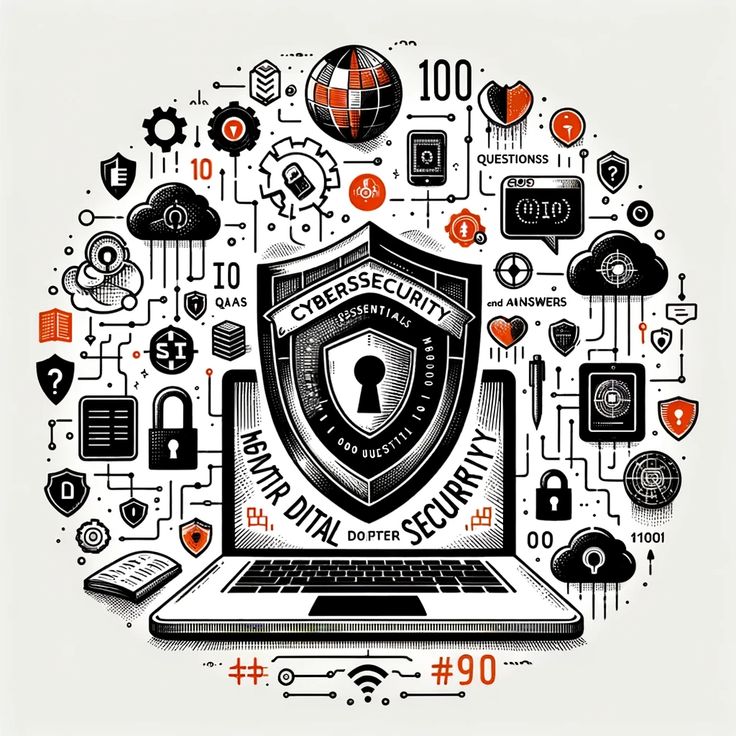Network Security:
Firewalls: Block unapproved access while permitting authentic correspondence.
Interruption Location Frameworks (IDS) and Interruption Counteraction Frameworks (IPS): Screen network traffic for dubious exercises and answer likely dangers.
Virtual Confidential Organizations (VPNs): Safely scramble information sent over the web.CyberSecurity.
Application Security:

Secure Coding Works on: Executing measures during advancement to forestall weaknesses.
Entrance Testing: Recreating assaults to recognize and fix security shortcomings.
Application Firewalls: Shield applications from dangers by sifting and observing HTTP traffic.
Endpoint Security:
Antivirus and Hostile to malware: Safeguard gadgets from noxious programming.
Endpoint Identification and Reaction (EDR): Screen and answer security dangers on endpoints.
Cell phone The board (MDM): Secure and oversee cell phones utilized in the association.
Information Security:
Encryption: Safeguard information by changing over it into an organization that must be perused by approved parties.
Information Misfortune Anticipation (DLP): Screen and control information moves to forestall unapproved access or breaks.
Reinforcement and Recuperation: Consistently back up information and carry out recuperation intends to guarantee information can be reestablished if there should arise an occurrence of misfortune.CyberSecurity.
Character and Access The board (IAM):
Confirmation: Check the character of clients through techniques like passwords, biometrics, or multifaceted validation (MFA).
Approval: Control client admittance to assets in view of their authorizations and jobs.
Single Sign-On (SSO): Permit clients to get to various frameworks with one bunch of qualifications.
Security Activities:
Security Data and Occasion The board (SIEM): Total and examine security information to distinguish and answer dangers.
Occurrence Reaction: Foster plans and systems to deal with and relieve the effect of safety episodes.
Danger Knowledge: Accumulate and examine data about potential and existing dangers to improve protection procedures.
Consistence and Administration:
Administrative Consistence: Guarantee adherence to regulations and guidelines like GDPR, HIPAA, and PCI-DSS.
Security Approaches: Create and uphold arrangements to direct security rehearses and guarantee predictable assurance measures.CyberSecurity.
Human Elements:
Security Mindfulness Preparing: Teach representatives about security dangers and best practices to forestall human mistake.
Phishing Reenactments: Test and train representatives to perceive and answer phishing assaults.
Actual Security:
Access Controls: Confine actual admittance to offices where delicate information and frameworks are put away.
Reconnaissance Frameworks: Screen and record exercises in regions with basic foundation.
Cloud Security:
Cloud Access Security Merchants (CASBs): Give perceivability and command over cloud administrations and information.
Encryption: Safeguard information put away in cloud conditions through encryption.
Danger Hunting:
Proactive Looking: Effectively search out expected dangers and weaknesses inside the organization before they manifest as assaults.
Conduct Examination: Investigate organization and client conduct to recognize oddities that might show a danger.
Man-made consciousness and AI in Network protection:

Inconsistency Discovery: Use man-made intelligence and ML calculations to distinguish uncommon examples or ways of behaving that could show security occurrences.
Mechanized Reaction: Carry out man-made intelligence driven answers for consequently answer specific sorts of dangers or assaults.
Zero Trust Engineering:
Guideline of Least Honor: Guarantee clients and gadgets have just the base degree of access expected for their undertakings.
Miniature Division: Gap the organization into more modest fragments to restrict horizontal development and contain possible breaks.
Ceaseless Confirmation: Routinely check the character and security stance of clients and gadgets.
Security for Web of Things (IoT):
Gadget The executives: Screen and secure IoT gadgets associated with the organization.
Network Division: Detach IoT gadgets from basic frameworks to decrease risk openness.
Firmware Updates: Consistently update IoT gadget firmware to fix weaknesses.
Network safety for Basic Foundation:
Modern Control Frameworks (ICS) Security: Safeguard frameworks that control modern cycles, like SCADA frameworks.
Danger Knowledge Sharing: Team up with different associations and government bodies to share data about dangers to basic foundation.
Information Protection:
Information Covering: Dark delicate information inside a data set to shield it from unapproved access.
Anonymization: Eliminate or modify individual data from datasets to forestall ID of people.
Online protection Administration:
Risk The board: Distinguish, survey, and focus on dangers to the association’s data resources.
Review and Consistence: Direct standard reviews to guarantee adherence to inside approaches and outer guidelines.
Security Structures: Execute perceived network safety systems, for example, NIST, ISO 27001, or COBIT.
Security in DevOps (DevSecOps):
Coordinated Security Testing: Integrate security testing into the improvement pipeline to early distinguish weaknesses.
Robotized Security Controls: Use computerization apparatuses to implement security approaches and controls in the improvement cycle.
Digital money and Blockchain Security
Cryptographic Securities: Guarantee secure exchanges and information trustworthiness in digital currency and blockchain frameworks.CyberSecurity.
Brilliant Agreement Reviews: Survey and review shrewd agreements for security weaknesses.
Social Examination
Client and Element Conduct Examination (UEBA): Screen and break down client and framework conduct to identify and answer potential security dangers.CyberSecurity.
Store network Security:
Merchant Chance Administration: Evaluate and oversee gambles related with outsider sellers and providers.
Secure Programming Advancement Lifecycle (SDLC): To guarantee that the products utilized in the store network are created with safety in mind, therefore, ensure that security considerations are integrated throughout the development process.
